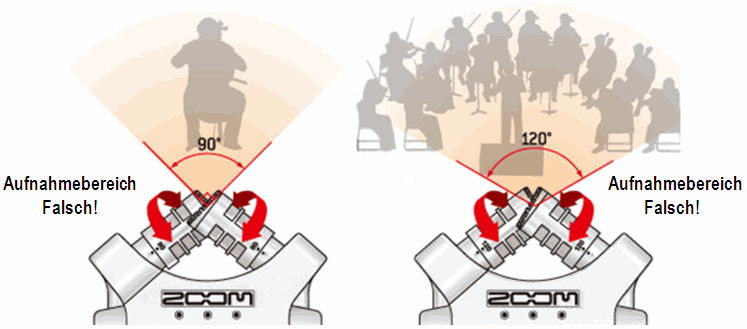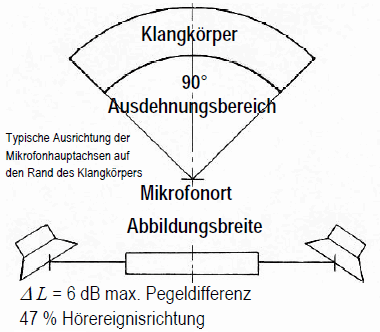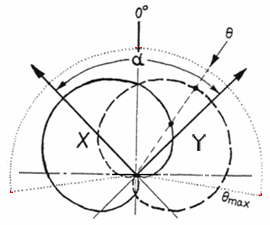

| Deutsche Version |
| Calculate the localisation direction for all X / Y coincident microphone systems - Excel calculation ● http://www.sengpielaudio.com/EBS-Hoerereignisrichtung-Koinzidenzmikrofon138.xls In this Excel program has been entered the full axis angle α = 138,44°, and if you scroll all the way down to "fine tuning of sound incidence angle" θ = 69,22° to find the calculated value of 18 dB or 100,04%. This produces for the sound incidence angle θmax = 69,22°. The Stereo Recording Angle = 2×θmax = 2 × 69,22° = 138,44°. For a X/Y coincident microphone (cardioid/cardioid) hereby the axis angle α = 138,44° is equal to the Stereo Recording Angle 138,44°. This value was found by a few computational experiments. The longer formulas used can be found in the Excel calculation. Here, A = 0,5; that means a cardioid microphone.. Level difference Δ L = ABS(20*LOG(ABS((A+(1-A)*COS(alpha*PI()/180/2+theta*PI()/180))/(A+(1-A)*COS(alpha*PI()/180/2-theta*PI()/180))))) Localisation direction in percentage b1 = IF((1,729349558*10^-4*theta^4-4,932667999*10^-3*theta^3-0,1485249855*theta*theta+8,81863307*theta)>=100,01;100;(1,729349558*10^-4*theta^4-4,932667999*10^-3*theta^3-0,1485249855*theta*theta+8,81863307*theta)) Theory fundamentals: "Intensity Stereophony" (Calculation X/Y level difference Δ L) - German: http://www.sengpielaudio.com/TheorieGrundlaIntensitaet.pdf "Berechnen der Hörereignisrichtung durch Interchannel-Pegeldifferenz Δ L und Interchannel-Laufzeitdifferenz Δ t bei Phantomschallquellen und Stereo-Lautsprecher" - German: http://www.sengpielaudio.com/Rechner-lokalisationskurven.htm "Andreas Gernemann-Paulsen, "Formeln und Werte für die Stereophonie" - German: http://www.uni-koeln.de/phil-fak/muwi/ag/umdruck/formst.pdf Attention, in Gernemann's article alpha is not specified as axis angle, but there are the terms of sound incidence angle or recording range and φ as the "microphone off-set angle" or "microphone opening angle". The specified at Gernemann "recording area α" (!) Is not the full range, but only half of it. With his microphone offset angle phi is meant probably my axis angle α. Formula according Gernemann for the level difference Δ L for a X/Y coincidence micophone cardioid/cardioid. (Parameter named after Sengpiel)
Resolved α ccording to the formula (without engagement):
α = the axis angle is the angle between the two main axes of the microphones θ = Angle of Incidence on the XY coincidence microphone system Δ L = level difference is 18 dB for the maximum angle of sound incidence ?max Receiving area = 2 × maximum sound incidence angle θmax (recording angle) |
| For locating a phantom sound source from the direction of a speaker on the stereo-speaker basis,
a level difference ofΔ L = 16 dB to 20 dB is needed, depending on the pulse composition and the
frequency composition of the audio signal. For calculating the mean value of Δ L there is simply
assumed Δ L = 18 dB; see: "hearing direction b1 in response to the interchannel level difference Δ L": http://www.sengpielaudio.com/HoerereignRichtungDL.pdf |
| Axis angle a = alpha (α) and incidence angle t = theta (θ) Δ L = 18 dB corresponds to a factor of 10(18/20) = 7.943282347242815 The case for coincident cardioids: 20*log10((1+cos(a/2+t))/(1+cos(a/2-t)))=7.94328 Solving for a: Log is not ln, but log to the base of 10. 20*log10((1+cos(a/2+t))/(1+cos(a/2-t)))=7.94328 (20*log(10, (1+cos(a/2+t))/(1+cos(a/2-t)))-7.94328)=0 http://www.wolframalpha.com/ (20*log(10, (1+cos(a/2+t))/(1+cos(a/2-t)))-7.94328)=0 http://www.wolframalpha.com/input/?i=(20*log(10, (1+cos(a/2+t))/(1+cos(a/2-t)))-7.94328)=0 solve (20*log(10, (1+cos(a/2+t))/(1+cos(a/2-t)))-7.94328)=0 for a http://www.wolframalpha.com/input/?i=solve (20*log(10, (1+cos(a/2+t))/(1+cos(a/2-t)))-7.94328)=0 for a It is a problem to resolve the following equation for a or α: Δ L = 20 · log (1 + cos (α/2 + θ)) / (1 + cos (α/2 - θ)) = 7.94328 (corresponding to 18 dB) Axis angle α = ??? |
| Axis angle α |
Recording angle α/2 |
Stereo recording angle 2 · θmax |
Sound incidence angle θmax |
| 60° | ±30° | 242,6° | ±121,3° |
| 70° | ±35° | 226,0° | ±113,0° |
| 80° | ±40° | 210,4° | ±105,2° |
| - - - 90° - - - | - - - ±45° - - - | - - - 196,0° - - - | - - - ±98,0° - - |
| 100° | ±50° | 182,4° | ±91,2° |
| 110° | ±55° | 169,8° | ±84,9° |
| 120° | ±60° | 158,0° | ±79,0° |
| 130° | ±65° | 147,2° | ±73,6° |
| 138,4° | ±69,2° | 138,4° | ±69,2° |
| 140° | ±70° | 136,8° | ±68,4° |
| 150° | ±75° | 127,2° | ±63,6° |
| 160° | ±80° | 118,4° | ±59,2° |
| 170° | ±85° | 109,8° | ±54,9° |
| 180° | ±90° | 101,8° | ±50,9° |
| The recording area of the microphone system is in the stereo recording technique the total
angle - seen from the microphone array, or the microphone system - where the sound
sources are situated and is completely spread oud when playing on the stereo loudspeaker
base from the direction of the speakers L and R. It is the maximum imaging range of the
sound between the loudspeakers. Only half the recording angle is often referred to as "recording range" is assumed. This causes confusion. The axis angle is referred by
Dickreiter and other sound authors as "opening angle" or "displacement angle" where
unfortunately not the angle between the microphones, but the recording angle, ie the angle of
the recording range is referred to, and sometimes the half angle is meant. Question: At which axis angle α the microphone axis shows exactly to the outer edges of the recording range 2×θmax? What is the axis angle to be adjusted for the smallest possible recording range 2×θmax and what value is the recording range? |
| "Aufnahmebereich von XY-Mikrofonen bei verschiedenen Achsenwinkeln – Richtcharakteristik: Niere /Niere": http://www.sengpielaudio.com/AufnahmebereichVonXYMikrofonenNiere.pdf "Der Aufnahmebereich des Mikrofonsystems – Wichtige berechnete Werte": http://www.sengpielaudio.com/AufnahmebereichWichtigeWerte.pdf "Visualisierung XY Stereo-Mikrofonsystem Niere/Niere 90° Intensitäts-Stereofonie": http://www.sengpielaudio.com/Visualization-XY90.htm "Visualisierung XY Stereo-Mikrofonsystem Niere/Niere 120° Intensitäts-Stereofonie": http://www.sengpielaudio.com/Visualization-XY120.htm "SRA Berechnung von Δ L und Δ t für Stereo-Mikrofonsysteme – flash": http://www.sengpielaudio.com/SRAflash.swf "Abbildungsbreite und Aufnahmebereich bei 'Intensitäts'-Stereofonie": http://www.sengpielaudio.com/Rechner-AufnahmebereichUndAchsenwinkel.htm "Der 'magische' Aufnahmebereich? ... oder eher der unverstandene Aufnahmewinkel von Mikrofonsystemen (Stereomikrofonen) in der Tontechnik": http://www.sengpielaudio.com/AufnahmebereichMikrofonsystem.htm "Taschenlampe und Aufnahmebereich": http://www.sengpielaudio.com/TaschenlampeUndAufnahmebereich.pdf "Der Aufnahmebereich des Mikrofonsystems – Wichtige berechnete Werte": http://www.sengpielaudio.com/AufnahmebereichWichtigeWerte.pdf "Abbildungsbreite und Aufnahmebereich bei 'Intensitäts'-Stereofonie": http://www.sengpielaudio.com/AbbildungsbreiteAufnahmebereichPegel.pdf "Der Aufnahmebereich von X/Y-Koinzidenzmikrofonen (Niere/Niere)": http://www.sengpielaudio.com/Koinzidenz1XYNiere-Niere.pdf "Ausdehnungsbereich des Klangkörpers": http://www.sengpielaudio.com/AusdehnungsbereichDesKlangkoerpers.pdf "Berechnen: Ausdehnungsbereich des Klangkörpers (Orchesterwinkel)": http://www.sengpielaudio.com/Rechner-ausdehnungsbereich.htm "Bestimmen von Aufnahmebereich und Hörereignisrichtung für jedes beliebige Stereo-Mikrofonsystem": http://www.sengpielaudio.com/BestimmenVonAufnahmebereich.pdf |
 |
 |
| In a X/Y microphone system cardioid/cardioid an axis angle of α = ±45° = 90° generates a large recording range of θmax = ±98° = 196°. In a X/Y microphone system cardioid/cardioid an axis angle of α = ±60° = 120° generates a slightly smaller recording range of ±79° = 158° |
| X/Y coincidence microphone system cardioid/cadioid – Axix angle of α = ±45° = 90°. |
 |
That makes a recording range of 2·θmax = ±98° = 196°. |
| Which user has in mind in this popular X/Y microphone system the large recording range of ±98° = 196°? The microphone manufacturers will never state this correctly. |
| "Zoom H4n Audio Recorder - Achsenwinkel und Aufnahmebereich": http://www.sengpielaudio.com/ZoomH4AudioRecorder.pdf "Das unmögliche Hauptmikrofon für "Intensitäts"-Stereofonie mit dem kleinen Achsenwinkel von α = 90°": http://www.sengpielaudio.com/DasUnmoeglicheHauptmikrofonFuerIntensitaet.pdf "So wird das Stereomikrofon NT4 der Firma Røde erklärt": http://www.sengpielaudio.com/DasStereomikrofonNT4.pdf |
| zurück |
Suchmaschine |
Startseite |